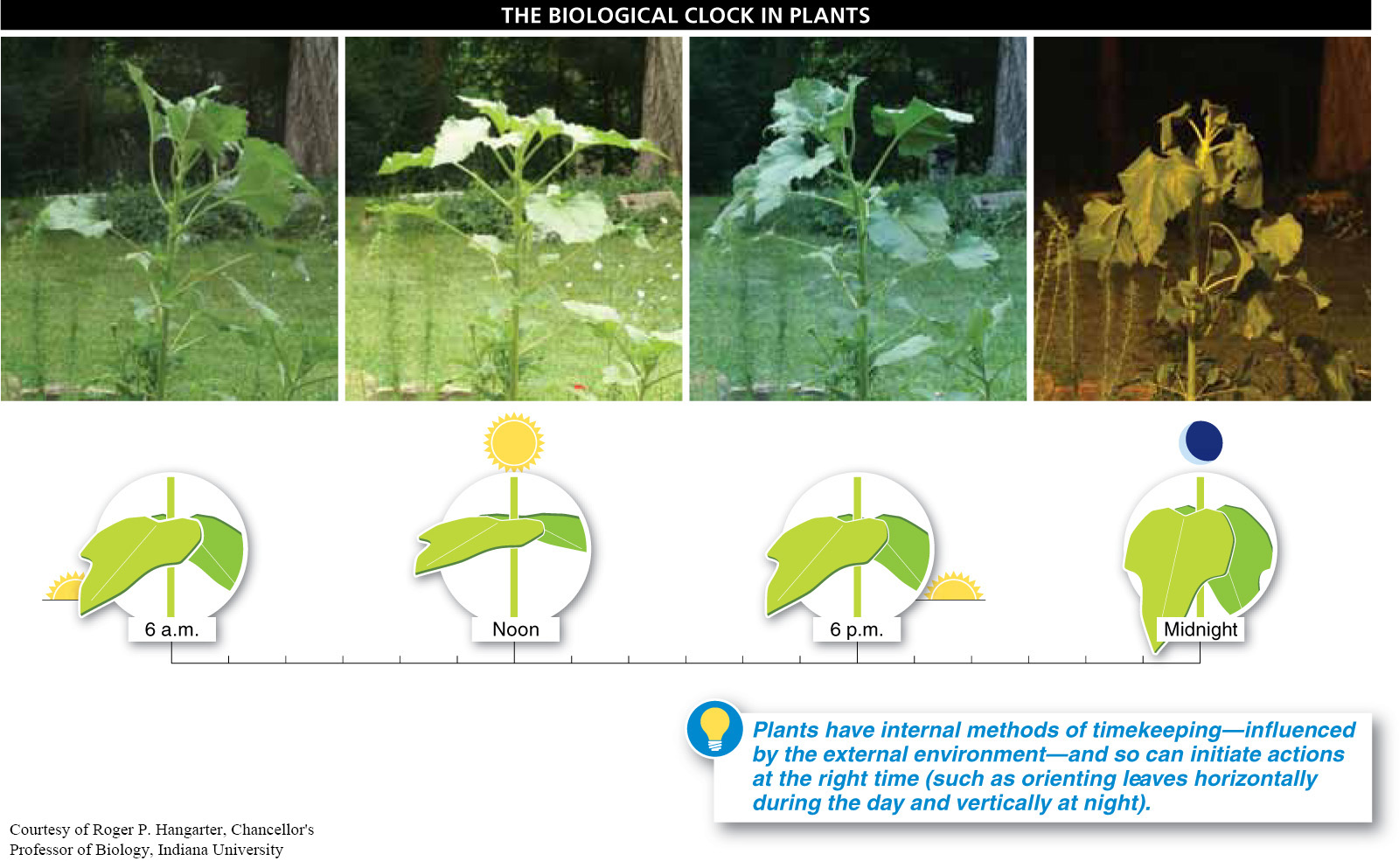19.9: Plants have internal biological clocks.
Plants are not as immobile as they appear. If you were to photograph or film a plant over a 24-hour period, as some botanists have done, you would observe many slow but sure movements. The common bean plant, for example, opens its leaves and orients them so that they face the sun during the day. Then each night, the plant pulls its leaves close to the stem (FIGURE 19-22). Similarly, in many moth-pollinated tobacco plants, the white trumpet-shaped flowers open each evening for their night-time pollination and close again in the morning. Do the plants respond to environmental cues to schedule their daily activities at the proper times? Or do they have some sort of built-in alarm clock?

Figure 19.22: Great timing. Plants adjust their biological clocks in response to environmental cues.
The answers are yes and yes. Plants do have a “biological clock,” an internal method of keeping time that tells the plant when to turn on or off the expression of certain genes. This internal clock makes possible the plant’s perpetually precise behavior—such as properly orienting leaves for efficient photosynthesis or making flowers accessible when pollinators are available. We know this because, even if the bean plants or tobacco plants described above are taken indoors and maintained in a room with constant, dim light, they still open their leaves or flowers on a daily schedule.
But this biological clock is not like a regular watch. As in so many aspects of biology, the events inside the organism are influenced by the world outside the organism. In other words, the internal clock of plants is continuously adjusted by environmental cues. When maintained under constant light conditions in the absence of external cues, the plants have anywhere from a 21-hour to a 27-hour cycle.
Consequently, after a while, they tend to get out of synch with the natural pattern of daylight and darkness. However, left outside with access to natural environmental cues, plants constantly adjust their clocks to those cues and maintain a cycle that always corresponds to the daily light-dark cycle. It’s as if plants sense that the environment is always the “correct” time and, if their clock is out of synch, they change it accordingly.
The most important environmental cues that set and reset a plant’s biological clock are light-dark cycles (but with a bit of input from temperature cycles). The precise mechanism by which plants keep track of time is not known for all species. In many plants, however, the mechanism seems to be regulated by pigments in the leaves that are sensitive to particular wavelengths of light. Because the specific wavelengths of light present in sunlight vary throughout the day, plants reliably have more of the pigments activated during the day, and different pigments are activated as the sun sets and night begins.
In the mid-1700s, Swedish botanist Carolus Linnaeus used his understanding of plants’ biological clocks to design what he called a “floral clock,” made of flowers that opened and closed at specific times of day. By planting a garden with 41 species that differed in their flowers’ opening and closing times, Linnaeus was able to tell the time of day just by noting which flowers were open and which were closed.
Q
Question
19.6
Could we tell time accurately just by looking at some flowers?
TAKE-HOME MESSAGE 19.9
Plants have internal methods of keeping time that enable them to initiate various biochemical and physiological actions at the appropriate times. They constantly adjust their biological clocks to environmental cues, such as light-dark cycles and temperature cycles.
If a tobacco plant opens its flowers in the evening and closes them again each morning, what can you infer about its pollinator?
